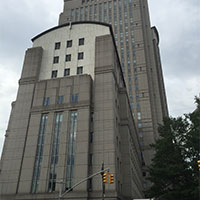Policies and Procedures
I. PURPOSE
Location Monitoring (LM) is a generic term which refers to any judicially or administratively imposed condition requiring an offender to remain in his/her residence for any portion of the day. There are numerous terms for the concept of LM, such as House Arrest, Home Detention, Home Confinement, etc. Unless otherwise specifically ordered by the Court within the Southern District of New York, location monitoring is to be monitored with the assistance of electronic monitoring.
Location Monitoring is used in lieu of detention, as a transitional confinement between incarceration, community supervision and when less restrictive conditions of release will not assure the community's safety. Location Monitoring is also appropriate for persons for whom jail environment is unsuitable because of illness, handicap, pregnancy or other physical condition. LM may also be an appropriate sanction for offenders who have violated the terms of previously imposed release conditions.
II. LOCATION MONITORING PROGRAM COMPONENTS
Similar to the prior home confinement program, the levels of restriction in the LM Program may range from a night curfew to a 24-hour home incarceration. The degree to which offenders are permitted to leave their homes is determined case by case and depends on the purpose and intent of the judicial officer or releasing authority:
- CURFEW - requires the participant to remain at home during set time periods of the day. For example, the offender is required to remain in his or her home between the hours of 8:00 p.m. to 6:00 a.m.
- HOME DETENTION - requires a participant to remain at home at all times except for pre-approved and scheduled absences for employment, education, religious activities, treatment, attorney visits, court appearances, court-ordered obligations, or other activities as approved by the officer.
- HOME INCARCERATION - is the most restrictive component of the location monitoring program. It requires 24-hour-a-day lock-down except for medical necessities and court appearances or other activities specifically approved by the court.
There are three (3) primary types of location monitoring technology:
- VOICE VERIFICATION/CALL VERIFIER SYSTEMS
* least restrictive and used only if the Court recommends "Location Monitoring Non-EM.". Under this system, the offender will call the system in accordance with their schedule. Additionally, they will receive random phone calls and home visits to ensure their compliance with the schedule.
- RADIO FREQUENCY (RF)
* the LM Program may incorporate an electronic monitoring system that includes monitoring equipment and 24 hour electronic surveillance designed to alert an officer when the offender leaves the residence or returns home late (or leaves early) from a pre-approved schedule, or tampers with the electronic monitoring equipment.
- GLOBAL POSITIONING SATELLITE (GPS)
* while subject to GPS monitoring, the offender's location is detected via Global Positing Systems satellites that transmits signals to location monitoring equipment on the ground. There are two types of GPS monitoring, Active GPS and Passive GPS. Active GPS provides the capability to continuously monitor an offender's movements in real-time. In regard the Passive GPS, the information pertaining to the offender's movement is downloaded to the vendor's management system which includes a mapping system.

